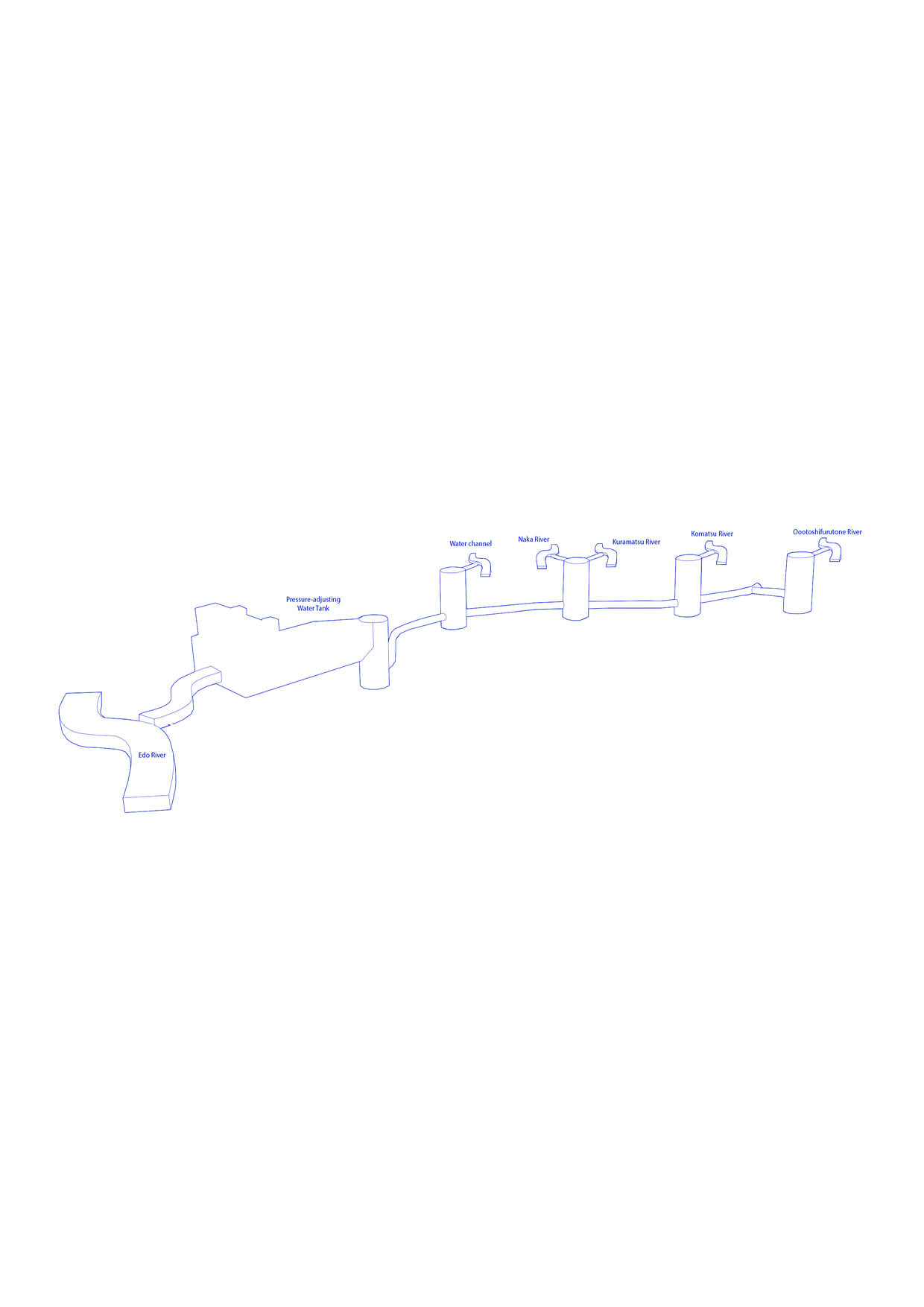
Fluctuat Nec Mergitur
Failure of a system, Underground, Building, Earthquake, Tokyo, Paris, Technology, Infrastructure, Drawing
Plenty of water can be a blessing and a curse. Both Tokyo, formerly Edo, and Paris have suffered damages from river overflow and heavy rainfalls since the beginning of time. It’s not reckless to say that Tokyo has suffered more than any other city because of its geographical location being continually affected by typhoons, tsunamis and earthquakes. With the high number of technological advances that Japanese engineers have developed over the years, it comes as no surprise that they designed the biggest discharge channel in the world to protect their cities.
The Metropolitan Area Outer Underground Discharge Channel, also known as G-cans, was in charge of the Japanese Government, specifically the Japan Institute of Wastewater Engineering Technology1 department and is located in Kasukabe, Saitama, one of the prefectures near the metropolitan area of Tokyo. This area is repeatedly devastated by flooding since early times because it features low-lying bowl-like terrain where water accumulates[2]. This underground tunnel system is in charge of mitigating the flood damage and protecting urban areas from overflowing water when natural disasters happen, and yes, they do happen regularly in Japan. When the rivers start to overflow, the tunnels start to fill immediately the tanks that are buried underground. Five buried tanks of water are connected to the Oootushifurutone River, Komatsu River, Kuramatsu River, Naka River. After these tanks are filled up, the water starts entering the 18 meters high pressure-adjusting water tank which reduces the force of the water flow through a pump facility and a drainage pump station to then discharge it in the Edo River smoothly through the drainage sluiceway. This complete circulation of water ends up flowing as an underground river that connects the smaller rivers with the Edo River. The entire drainage channel is controlled from the operation room in the administration building.
1. Water Technology, “G-Cans project, Kasukabe, Saitama, Greater Tokyo Area”, Kaori Shoji, Accessed March 14, 2020. https://www.water-technology.net/projects/g-cans-project-tokyo-japan/
2. Edogawa River Office, “The Metropolitan Outer Area Underground Discharge Channel”, Accessed March 14, 2020. https://www.ktr.mlit.go.jp/edogawa/edogawa00576.html
See photos: Tokyo
See ephemera: 60, 61
Failure of a system, Underground, Building, Earthquake, Tokyo, Paris, Technology, Infrastructure, Drawing
Plenty of water can be a blessing and a curse. Both Tokyo, formerly Edo, and Paris have suffered damages from river overflow and heavy rainfalls since the beginning of time. It’s not reckless to say that Tokyo has suffered more than any other city because of its geographical location being continually affected by typhoons, tsunamis and earthquakes. With the high number of technological advances that Japanese engineers have developed over the years, it comes as no surprise that they designed the biggest discharge channel in the world to protect their cities.
The Metropolitan Area Outer Underground Discharge Channel, also known as G-cans, was in charge of the Japanese Government, specifically the Japan Institute of Wastewater Engineering Technology1 department and is located in Kasukabe, Saitama, one of the prefectures near the metropolitan area of Tokyo. This area is repeatedly devastated by flooding since early times because it features low-lying bowl-like terrain where water accumulates[2]. This underground tunnel system is in charge of mitigating the flood damage and protecting urban areas from overflowing water when natural disasters happen, and yes, they do happen regularly in Japan. When the rivers start to overflow, the tunnels start to fill immediately the tanks that are buried underground. Five buried tanks of water are connected to the Oootushifurutone River, Komatsu River, Kuramatsu River, Naka River. After these tanks are filled up, the water starts entering the 18 meters high pressure-adjusting water tank which reduces the force of the water flow through a pump facility and a drainage pump station to then discharge it in the Edo River smoothly through the drainage sluiceway. This complete circulation of water ends up flowing as an underground river that connects the smaller rivers with the Edo River. The entire drainage channel is controlled from the operation room in the administration building.
1. Water Technology, “G-Cans project, Kasukabe, Saitama, Greater Tokyo Area”, Kaori Shoji, Accessed March 14, 2020. https://www.water-technology.net/projects/g-cans-project-tokyo-japan/
2. Edogawa River Office, “The Metropolitan Outer Area Underground Discharge Channel”, Accessed March 14, 2020. https://www.ktr.mlit.go.jp/edogawa/edogawa00576.html
See photos: Tokyo
See ephemera: 60, 61


